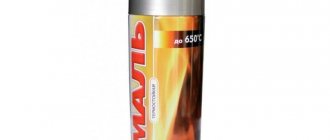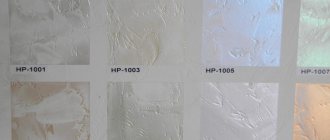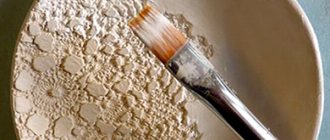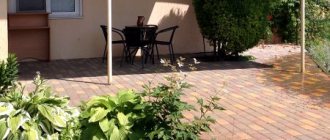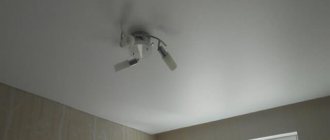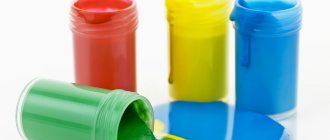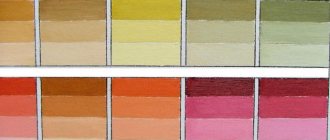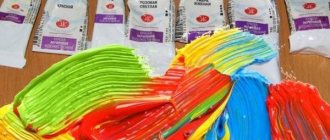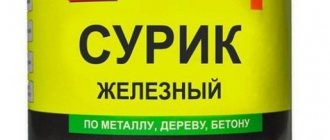Types of pigments for paints and application features
Pigments for paints are finely ground powders diluted with special substances that are added to paints and varnishes. Multi-colored paints (colors) are made by mixing different pigments.
Pigmenting agents can be broadly classified as either artificial or natural.
By the way, the latter can be divided into inorganic and organic, and there are not so many natural substances, but they are actively used in construction, because their use will be much cheaper than the production of artificial components.
Varieties
Pigments of natural origin
So, let's take a closer look.
Mineral dyes
Pigments made on a natural base are extracted from oxides and metals. Sources for obtaining dyes also include inorganic elements with colors such as:
Iron oxides (brown, yellow and red).- Manganese (brown, purple and yellow).
- Chrome (green).
- Antimony (yellow).
- Copper oxide (red, emerald and bright green).
- Ocher (dark yellow, golden, pale yellow, and red when heated).
- Mars (dark and light brown).
- Umber (red-brown and green-brown).
- Ultramarine (bright blue).
- Van-dyk (brown).
Mineral-type dyes are characterized by a high degree of strength, are resistant to light, have excellent miscibility and compatibility with binders.
Characteristics of certain inorganic pigments:
- Dry ocher. It is extracted from clay-type minerals that are colored by hydrated iron oxides. The dry color of ocher is yellow-brown or simply yellow. Ocher is used as a coloring agent in the creation of cement mortar, which will be used to obtain a decorative appearance of plaster. It is also used in the creation of adhesive and silicate paint and varnish compositions. Products containing ocher are perfect for painting wood, concrete and metal products. The pigment has excellent coverage, strength and resistance to alkalis and light.
- Sienna of natural origin. Another dry pigment for paint, or rather a yellow clay coloring substance. It looks very much like ocher, but sienna contains a lot of iron oxide, as well as silica. Sienna is resistant to alkalis, lime and is used in almost all types of paint. When mixed with oil, sienna acquires glaze characteristics, and the compositions are also often used for finishing work on expensive wood species.
- Iron red lead. It includes iron oxide and traces of quartz-type minerals. The color of the dye is reddish-brown. The pigment is extracted by finely grinding iron ores. The substance itself is not poisonous, but its dust may contain toxins. Different grades of red lead are used to add special-purpose primers and paints and varnishes to alkyd types (for painting ships and anti-corrosion compositions). Lead also has found application in oil compositions for painting metal products that are located outdoors. The cost of manufacturing the element is low, and therefore it is used for enamels and adhesive paints.
- Natural umber. The pigment will include iron and manganese oxides. The color of umber is brown with a hint of dark yellow or green. As a result of calcination, the umber will acquire a red-brown color. The dye has an increased level of strength and excellent coloring properties. The addition of umber allows the oils to dry much faster, and the coloring agent is used to color plaster, wood and metal products.
- Chromium oxide. The pigment is made through complex chemical reactions and the color ranges from light green to dark green. The disadvantage of chromium oxide is its explosive hazard, fire hazard and toxicity. The advantages of the substance are high resistance to light, strength, resistance to alkalis and acids even at high temperatures. The pigment can be added to all sorts of pigments, and chromium oxide is used for critical coatings in chemical plants, pipe surfaces, and equipment that is constantly exposed to high thermal stress.
- Red lead. Its color can be bright orange or orange-red. It is heavy and is also a product of the oxidation of lead litharge at high temperatures. Red lead is a highly toxic material, and the pigment will be characterized by high alkali resistance, excellent hiding power and anti-corrosion properties. Red lead is characterized by low resistance to all kinds of acids.
- Brown Mars. The color, as the name suggests, is dark brown or light brown. The pigment is made by calcining a mixture that contains manganese, iron oxide, and also aluminum oxide hydrate. Mars has excellent resistance to light and alkalis, as well as an acceptable level of hiding power and glaze properties. The component is used with binders in non-aqueous and aqueous formulations. The coloring agent is used for painting wooden and metal products, as well as plastered surfaces.
- Emerald green. The dye has high glazing properties and is resistant to light, gases and humidity.
- Cobalt blue. In this case, the color is bright blue, and the substance is resistant to light, and also perfectly tolerates the effects of precipitation, and is characterized by high glaze and drier properties. Cobalt blue is characterized by increased oil capacity and low hiding power.
- Prussian blue is resistant to light, and is also characterized by color intensity and hiding power.
Next, let's look at another type of dye.
Organic dyes
Pigments added to paints can be organic, in which case organics are derived from plants and insects. These types of dyes, unlike the same mineral dyes, can be dissolved in water, alcohol and oil. Organics will be characterized by a lower degree of strength compared to mineral dyes, and since such pigments do not create a layer of paint, but enter the surface structure, they are most often used when dyeing fabric. The most popular type of organic matter is kraplak, which is extracted from the roots of krapa or madder. Another plant substance is indigo, which is obtained from woad. With modern industry they can even make synthetic indigo. Pigments of light brown color are obtained from sea mollusks, and black coloring substances are obtained from organic materials through the calcination method.
Artificial pigments
Synthetic coloring substances are distinguished by the maximum degree of resistance to moisture, atmospheric precipitation, light and gases. They are characterized by the brightness of their colors, and due to this set of qualities, pigments of artificial origin have long been able to take a leading place among other types of dyes. Pigments of synthetic origin can be classified as mineral or inorganic. The latter dyes are produced through complex chemical reactions, and synthetic inorganic pigments are characterized by a constant chemical structure, pure and bright color.
Please note that the cost of manufacturing such components is quite expensive compared to natural coloring compounds. Inorganic synthetics are used for the construction industry to make non-aqueous paint and varnish compositions.
Synthetic mineral pigments are made by combining two or three components. According to the production method, such dyes can be divided into those precipitated from metal solutions and salts or made by calcination.
Ultramarine
It can be classified as a type of inorganic synthetic dye. It contains sulfur and sodium aluminum silicate. Ultramarine is often used for the construction field and in paints, non-aqueous and water-based paints and varnishes. These paints are also used to paint metal, concrete, wood and plastered surfaces. Ultramarine is used very rarely in its pure form, and when it does happen, the purpose is usually to neutralize the yellow coloration from chalk or lime. Ultramarine is also used as a glaze dye. The pigment is resistant to alkalis and light. But adding a coloring agent to the lime mortar is undesirable, because in this case the substance will lose color. Ultramarine is suitable for interaction with all types of binders when performing external and internal finishing work.
Cinnabar
This dye is characterized by a bright red color, but can also be in dark colors. Cinnabar can be used to produce all types of paints and varnishes that are used for painting brick, concrete, wood and plastered surfaces. Can be used for both interior and exterior finishing work.
How to use dry paints and pigments correctly
Before use, the pigment must be sifted on a sieve to separate lumps. Then you need to dilute the dry paint in water. It is not recommended to immediately dilute pigments in a binding liquid, since it is almost impossible to obtain a uniform consistency (except by stirring in a mixer). Next, the aqueous suspension of dry paint must be diluted thoroughly, with constant stirring, in the special liquid for which it is intended. It is necessary to mix thoroughly to obtain a uniform liquid solution of medium viscosity, without lumps. This solution of pigments is called color. You can choose different colors and tones, mixing different colors and achieving exactly the shade that you need.
Silicate dyes
Mineral silicate paints are used to process both interiors and facades of houses. The silicate composition can be applied to any mineral base. After drying, a heat-resistant, fire-resistant protective layer is formed, which is resistant to ultraviolet rays and atmospheric influences, while it has vapor and air permeability.
In accordance with GOST, silicate paint is a suspension consisting of filler, alkali-resistant pigment substances, silicate agents, all these components are in a liquid mixture of potassium glass. When this composition is applied to the base, it forms a protective, decorative, waterproof layer that penetrates deeply into the structure of the mineral material. Some manufacturers add zinc and aluminum dust (powder) to this paint, due to which it acquires anti-corrosion characteristics.
Silicators are active components that penetrate deep into the material being painted, react with it and create a layer that is insoluble in water. Thanks to this, all pores and cracks are clogged, and a waterproof structure is formed.
By adding various fillers and substances to silicate paint, for example, ground glass, fireclay, expanded perlite and others, you can create unique, textured, very attractive surfaces. However, the use of special additives will limit the choice of paint shade.
If we compare lime, cement and silicate paint mixtures, silicate compositions are the most difficult to apply. They are usually made in 2 containers. Potassium glass is contained in a metal or glass container, and pigments and fillers are supplied in bags. These substances must be mixed with each other before staining begins. Before painting, be sure to remove old paint and varnish material from the surface. After cleaning, priming is carried out either with silicate primer or silicate paint.
To extend the service life of the silicate coating, four-layer painting is used. The first layer is an etching layer, then a priming layer, after which two main, finishing layers are applied. Thanks to this treatment, the service life of the painted surface reaches 20 years. Foreign consumers call silicate dyes mineral dyes.
Dictionary
Covering power - the ability of a pigment to hide the painted surface under a layer of paint film, is determined by the number of grams of paint consumed per 1 m2 of surface.
Silicators are active substances that penetrate deeply into the surface to be painted and react there, forming water-insoluble compounds. This leads to clogging of the pores, which leads to the formation of waterproof structures.
If you are interested in natural paints, you may also find it helpful to know what wood wax paints are. We talked about this in a special article.
Scope of application of CM
A dry mixture of mineral paint is considered ready for use if its composition is diluted with a solvent. It is diluted with liquid. Used for diluting cement, casein, silicate.
- Casein dye is used for mineral facades and wall cladding inside house buildings.
- Brick, plaster, concrete are coated with liquid glass or silicate mineral paint. A film forms on the surface.
- For decoration inside the house, to embody artistic ideas, gouache or decorative dyes are used. They are diluted with liquid. The surface is covered with a durable matte film.
Mineral compositions are ways to improve the appearance of the facade. They are often used in restoration work, which extends the life of the brick or concrete facade of a house located in a damp area.
Mineral CM is used for indoor cladding. It is a protective material for wood and metal.
Classification of mineral compositions
- According to the amount of pigment in the composition of CM there are:
- natural if there is only one pigment and it sets the color of the coating. For example, lime products from Auro (Germany) are used for the design of new buildings and the restoration of old ones. For 5.0 kg the price is 65 euros, material consumption is up to 50 m2;
- artificial if it combines different color bases. This group includes mineral cement-lime paint Osnovit Univita CC90 for 20 kg 1225.0 rubles, mixture consumption - 0.3-0.6 kg/m2.
- Since the dry mixture cannot be applied to the surface, it is diluted. Based on the solvent, mineral compositions are grouped into groups:
- CM of lime composition. For dilution, lime milk with the addition of table salt, aluminum alum, and calcium chloride is used. The covering material is light in color, has a short service life, and is inexpensive. Does not interact well with cement-based plaster. Lime whitewash paste 3.0 kg for 139 rubles, Lime Venetian plaster in powder Tadelakt Influence for 3 kg - 297 rubles.
- Cement dyes. Waterproof coating is used for internal and external work, for industrial premises with high humidity.
- Silicate compounds. Fillers (talc, chalk) with alkali-resistant pigments are introduced. The coating resists negative atmospheric conditions, exposure to water, temperature fluctuations, and can be applied to any substrate. This group includes silicate paints for facades Sadolin Silikat (for 5 liters - 5500 rubles), facade KM Kema and Baumit, facade dye of the Caparol brand.
- In oil paints, pigments are dissolved in various drying oils. These mineral compositions are produced in factories. Using special equipment, a homogeneous suspension is obtained by grinding. The material is wear-resistant, has a long service life, and often serves as a primer before painting. This is an anti-corrosion coating for metal and protection against waterlogging for wood. KM series MA-15 and “Kazachok” are in demand. For example, Iron Surik MA-15 “Mega Paints”, 0.9 kg for 99.00 rubles.
Limestone
This type of mineral paint is usually used for outdoor use. The base of this paint is slaked lime, to which table salt and alum can be added to increase the durability of the finished coating. Alkali-resistant substances are used as pigments, for example, soot, umber, red lead, mummy, ocher, sienna, etc. These pigments must be used in a paste form; their consistency should resemble sour cream. These substances are first soaked in water, and in this state they are added to the mineral paint.
The color of such mineral paint can be “bleached” or pastel. The degree of coverage depends on the consistency of the dye and the number of layers applied. The hiding power is the ability of paint to hide the material being painted. Covering power is determined by the volume of the color mixture, which is consumed per square meter of surface.
Although such mineral paint can be made with your own hands and will not be expensive, it is very short-lived, its service life is 1-2 years. It is easily washed off the surface, but is also quickly applied again. The service life of such a coating can be extended to 4 years, subject to the following painting technology:
- thoroughly clean and putty the surface first;
- Apply a coat of primer using a brush or wide brush. After the soil has dried, liquid lime paint must be rubbed into the surface with force so that all pores and cracks are reliably filled;
- after the first layer has dried, it is necessary to apply the second, main layer using a spray bottle or brush.

